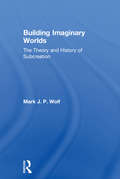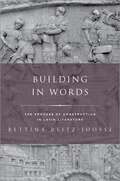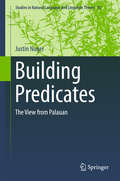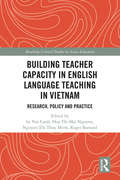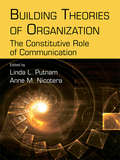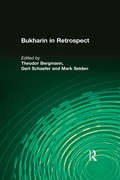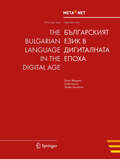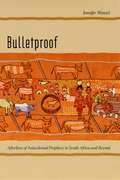- Table View
- List View
Building Imaginary Worlds: The Theory and History of Subcreation
by Mark J.P. WolfMark J.P. Wolf’s study of imaginary worlds theorizes world-building within and across media, including literature, comics, film, radio, television, board games, video games, the Internet, and more. Building Imaginary Worlds departs from prior approaches to imaginary worlds that focused mainly on narrative, medium, or genre, and instead considers imaginary worlds as dynamic entities in and of themselves. Wolf argues that imaginary worlds—which are often transnarrative, transmedial, and transauthorial in nature—are compelling objects of inquiry for Media Studies. Chapters touch on: a theoretical analysis of how world-building extends beyond storytelling, the engagement of the audience, and the way worlds are conceptualized and experienced a history of imaginary worlds that follows their development over three millennia from the fictional islands of Homer’s Odyssey to the present internarrative theory examining how narratives set in the same world can interact and relate to one another an examination of transmedial growth and adaptation, and what happens when worlds make the jump between media an analysis of the transauthorial nature of imaginary worlds, the resulting concentric circles of authorship, and related topics of canonicity, participatory worlds, and subcreation’s relationship with divine Creation Building Imaginary Worlds also provides the scholar of imaginary worlds with a glossary of terms and a detailed timeline that spans three millennia and more than 1,400 imaginary worlds, listing their names, creators, and the works in which they first appeared.
Building in Words: Representations of the Process of Construction in Latin Literature (Classical Culture and Society)
by Bettina Reitz-JoosseBuilding in Words explores the relationship between text and architecture in the Roman world from the perspective of architectural process. Ancient Romans frequently encountered buildings under construction - they experienced noisy building work, disruptive transportation of materials, and sometimes spectacular engineering feats. Bettina Reitz-Joosse analyzes how Roman authors responded to the process of building and construction in their literary works. Roman authors tell stories of architectural creation to give meaning to finished monuments. Their narratives can stress technological or logistic mastery or highlight morally problematic aspects of construction, particularly in large-scale engineering projects. While offering descriptions of the process of creating architecture, Roman writers also reflect on the creation of their own works. Building in Words demonstrates the richness of the image of construction for literary composition: writers use it to comment on the aesthetics or ambition of their literary work, to articulate the power and durability, but also the fragility of literature. Reitz-Joosse here offers original readings of a range of literary authors of the early Roman empire, including Vergil, Pliny the Elder, Tacitus, and Statius, and places literary texts in dialogue with contemporary epigraphic and archaeological material. Through its focus on building as a process, Building in Words furthers our understanding of the aesthetics of both architecture and literature in ancient Rome.
Building in Words: Representations of the Process of Construction in Latin Literature (Classical Culture and Society)
by Bettina Reitz-JoosseBuilding in Words explores the relationship between text and architecture in the Roman world from the perspective of architectural process. Ancient Romans frequently encountered buildings under construction - they experienced noisy building work, disruptive transportation of materials, and sometimes spectacular engineering feats. Bettina Reitz-Joosse analyzes how Roman authors responded to the process of building and construction in their literary works. Roman authors tell stories of architectural creation to give meaning to finished monuments. Their narratives can stress technological or logistic mastery or highlight morally problematic aspects of construction, particularly in large-scale engineering projects. While offering descriptions of the process of creating architecture, Roman writers also reflect on the creation of their own works. Building in Words demonstrates the richness of the image of construction for literary composition: writers use it to comment on the aesthetics or ambition of their literary work, to articulate the power and durability, but also the fragility of literature. Reitz-Joosse here offers original readings of a range of literary authors of the early Roman empire, including Vergil, Pliny the Elder, Tacitus, and Statius, and places literary texts in dialogue with contemporary epigraphic and archaeological material. Through its focus on building as a process, Building in Words furthers our understanding of the aesthetics of both architecture and literature in ancient Rome.
Building on Knowledge: Developing Expertise, Creativity and Intellectual Capital in the Construction Professions
by David BartholomewThis guide shows design practices and other construction professionals how to manage knowledge successfully. It explains how to develop and implement a knowledge management strategy, and how to avoid the pitfalls, focusing on the techniques of learning and knowledge sharing that are most relevant in professional practice. Expensive IT-based ‘solutions’ bought off-the-shelf rarely succeed in a practice context, so the emphasis here is on people-centred techniques, which recognise and meet real business knowledge needs and fit in with the organisational culture. Knowledge is supplanting physical assets as the dominant basis of capital value and an understanding of how knowledge is acquired, shared and used is increasingly crucial in organisational success. Most business leaders recognise this, but few have yet succeeded in making it the pervasive influence on management practice that it needs to become; that has turned out to be harder than it looks. Construction professionals are among those who have furthest to go, and most to gain. Design is a knowledge-based activity, and project managers, contractors and clients, as well as architects and engineers, have always learned from experience and shared their knowledge with immediate colleagues. But the intuitive processes they have traditionally used break down alarmingly quickly as organisations grow; even simply dividing the office over two floors can noticeably reduce communication. At the same time, increasingly sophisticated construction technology and more demanding markets are making effective management of knowledge ever more important. Other knowledge-intensive industries (such as management consultancy, pharmaceuticals, and IT), are well ahead in adopting a more systematic approach to learning and sharing knowledge, and seeing the benefits in improved technical capacity, efficiency, customer satisfaction and reduced risk.
Building Predicates: The View from Palauan (Studies in Natural Language and Linguistic Theory #92)
by Justin NugerThis volume provides a comprehensive analysis of the syntax of Palauan that will appeal to anyone interested in Austronesian languages or formal syntactic and morphological theory. This volume proposes that words in Palauan are not drawn directly from a mental lexicon, but are instead composed at least partially in the syntax. Using original data from syntactic constructions not previously explored in the language, the author entertains several competing theories of word formation and highlights the compatible and incompatible aspects of each, through an exploration into new corners of Palauan syntax and morphology.
Building Socialism: Architecture and Urbanism in East German Literature, 1955-1973 (New Directions in German Studies)
by Curtis SwopeBuilding Socialism reveals how East German writers' engagement with the rapidly changing built environment from the mid-1950s to the early 1970s constitutes an untold story about the emergence of literary experimentation in the post-War period. It breaks new ground by exploring the centrality of architecture to a mid-century modernist literature in dialogue with multiple literary and left-wing theoretical traditions and in tune with international assessments of modernist architecture and urban planning. Design and construction were a central part of politics and everyday life in East Germany during this time as buildings old and new were asked to bear heavy ideological and social burdens. In their novels, stories, and plays, Heiner Müller, Christa Wolf, Günter Kunert, Volker Braun, Günter de Bruyn, and Brigitte Reimann responded to enormous new factory complexes, experimental new towns, the demolition of Berlin's tenements, and the propagation of a pared-down modernist aesthetic in interior design. Writers' representation of the design, construction, and use of architecture formed part of a turn to modernist literary devices, including montage, metaphor, and shifting narrative perspectives. East Germany's literary architecture also represents a sophisticated theoretical reflection on the intractable problems of East Germany's socialist modernity, including the alliance between state socialism and technological modernization, competing commitments to working-class self-organization and the power of specialist planners and designers, and the attempt to create an alternative to fascism.
Building Socialism: Architecture And Urbanism In East German Literature, 1955-1973 (New Directions In German Studies #19)
by Dr Curtis SwopeBuilding Socialism reveals how East German writers' engagement with the rapidly changing built environment from the mid-1950s to the early 1970s constitutes an untold story about the emergence of literary experimentation in the post-War period. It breaks new ground by exploring the centrality of architecture to a mid-century modernist literature in dialogue with multiple literary and left-wing theoretical traditions and in tune with international assessments of modernist architecture and urban planning. Design and construction were a central part of politics and everyday life in East Germany during this time as buildings old and new were asked to bear heavy ideological and social burdens. In their novels, stories, and plays, Heiner Müller, Christa Wolf, Günter Kunert, Volker Braun, Günter de Bruyn, and Brigitte Reimann responded to enormous new factory complexes, experimental new towns, the demolition of Berlin's tenements, and the propagation of a pared-down modernist aesthetic in interior design. Writers' representation of the design, construction, and use of architecture formed part of a turn to modernist literary devices, including montage, metaphor, and shifting narrative perspectives. East Germany's literary architecture also represents a sophisticated theoretical reflection on the intractable problems of East Germany's socialist modernity, including the alliance between state socialism and technological modernization, competing commitments to working-class self-organization and the power of specialist planners and designers, and the attempt to create an alternative to fascism.
Building Students' Historical Literacies: Learning to Read and Reason with Historical Texts and Evidence
by Jeffery NokesHow can teachers incorporate the richness of historical resources into classrooms in ways that are true to the discipline of history and are pedagogically sound? This book explores the notion of historical literacy, adopts a research-supported stance on literacy processes, and promotes the integration of content-area literacy instruction into history content teaching. It is unique in its focus on the discipline-specific literacies of historical inquiry. Addressing literacy from a historian’s rather than a a literacy specialist’s point of view, this book surveys a broad range of texts including those that historians and non-historians both use and produce in understanding history; and includes a wide variety of practical instructional strategies immediately available to teachers. History teachers who read this book will receive the practical tools they need in order to help their students reach the national standards for history teaching. With the recent inclusion of a historical literacy component of the English Language Arts Common Core Standards Initiative, this book is also highly relevant to English, language arts, and reading teachers, who are expected, under the new guidelines, to engage their students in historical reading and writing. Visit historicalliteracies.byu.edu for additional information and resources on teaching historical literacies.
Building Students' Historical Literacies: Learning to Read and Reason with Historical Texts and Evidence
by Jeffery NokesHow can teachers incorporate the richness of historical resources into classrooms in ways that are true to the discipline of history and are pedagogically sound? This book explores the notion of historical literacy, adopts a research-supported stance on literacy processes, and promotes the integration of content-area literacy instruction into history content teaching. It is unique in its focus on the discipline-specific literacies of historical inquiry. Addressing literacy from a historian’s rather than a a literacy specialist’s point of view, this book surveys a broad range of texts including those that historians and non-historians both use and produce in understanding history; and includes a wide variety of practical instructional strategies immediately available to teachers. History teachers who read this book will receive the practical tools they need in order to help their students reach the national standards for history teaching. With the recent inclusion of a historical literacy component of the English Language Arts Common Core Standards Initiative, this book is also highly relevant to English, language arts, and reading teachers, who are expected, under the new guidelines, to engage their students in historical reading and writing. Visit historicalliteracies.byu.edu for additional information and resources on teaching historical literacies.
Building Students' Historical Literacies: Learning to Read and Reason With Historical Texts and Evidence
by Jeffery D. NokesHow can teachers incorporate the richness of historical resources into classrooms in ways that are true to the discipline of history and are pedagogically sound? Now in its second edition, this book explores the notion of historical literacy, adopts a research-supported stance on literacy processes, and promotes the integration of content-area literacy instruction into history content teaching. Providing an original focus on the discipline-specific literacies of historical inquiry, the new edition presents a deeper examination of difficult histories and offers new strategies that can be applied to all genres of historical inquiry. Nokes surveys a broad range of texts, including those that historians and nonhistorians both use and produce in understanding history, and provides a wide variety of practical instructional strategies immediately available to teachers. Featuring new examples and practical resources, the new edition highlights the connection between historical literacies and the critical reading and communication skills that are necessary for informed civic engagement. Equipped with study guides, graphic organizers, and scoring guides for classroom use, this text is an essential resource for preservice and practicing teachers in literacy and social studies education.
Building Students' Historical Literacies: Learning to Read and Reason With Historical Texts and Evidence
by Jeffery D. NokesHow can teachers incorporate the richness of historical resources into classrooms in ways that are true to the discipline of history and are pedagogically sound? Now in its second edition, this book explores the notion of historical literacy, adopts a research-supported stance on literacy processes, and promotes the integration of content-area literacy instruction into history content teaching. Providing an original focus on the discipline-specific literacies of historical inquiry, the new edition presents a deeper examination of difficult histories and offers new strategies that can be applied to all genres of historical inquiry. Nokes surveys a broad range of texts, including those that historians and nonhistorians both use and produce in understanding history, and provides a wide variety of practical instructional strategies immediately available to teachers. Featuring new examples and practical resources, the new edition highlights the connection between historical literacies and the critical reading and communication skills that are necessary for informed civic engagement. Equipped with study guides, graphic organizers, and scoring guides for classroom use, this text is an essential resource for preservice and practicing teachers in literacy and social studies education.
Building Teacher Capacity in English Language Teaching in Vietnam: Research, Policy and Practice (Routledge Critical Studies in Asian Education)
by Le Van Canh Hoa Thi Mai Nguyen Nguyen Thi Thuy Minh Roger BarnardThis timely volume opens a window on issues related to English language education in Vietnam. The authors consider that teacher quality is the key factor to be considered if the national English language curriculum outcomes are to be achievable. Aiming to shed light on key issues recently observed in the Vietnamese landscape of English language education, it examines the complexity of the institutionalization of the standardized English proficiency policy, which has been in force since 2008. That policy uses the Common European Framework of References for Languages (CEFR) as the model to set the standards and levels of proficiency for teachers, learners and state employees. The book presents both the theoretical and practical aspects of the standardization movement in English language education. The contents comprise a series of extended research-based chapters written by experts of language-in-education policy and planning in and about Vietnam from a range of perspectives including teachers, English language curriculum developers, teacher educators and researchers. The rich coverage of the book includes current discussion on English language education in Vietnam ranging from policy to practice, making it highly relevant to English teachers, teacher educators, and scholars, in Vietnam and worldwide, who aspire to broaden their horizons and professionalism.
Building Teacher Capacity in English Language Teaching in Vietnam: Research, Policy and Practice (Routledge Critical Studies in Asian Education)
by Van Canh Le Hoa Thi Mai Nguyen Thi Thuy Minh Nguyen Roger BarnardThis timely volume opens a window on issues related to English language education in Vietnam. The authors consider that teacher quality is the key factor to be considered if the national English language curriculum outcomes are to be achievable. Aiming to shed light on key issues recently observed in the Vietnamese landscape of English language education, it examines the complexity of the institutionalization of the standardized English proficiency policy, which has been in force since 2008. That policy uses the Common European Framework of References for Languages (CEFR) as the model to set the standards and levels of proficiency for teachers, learners and state employees. The book presents both the theoretical and practical aspects of the standardization movement in English language education. The contents comprise a series of extended research-based chapters written by experts of language-in-education policy and planning in and about Vietnam from a range of perspectives including teachers, English language curriculum developers, teacher educators and researchers. The rich coverage of the book includes current discussion on English language education in Vietnam ranging from policy to practice, making it highly relevant to English teachers, teacher educators, and scholars, in Vietnam and worldwide, who aspire to broaden their horizons and professionalism.
Building the Literacy Block: Structuring the Ultimate ELA Workshop
by Bridget M. SpackmanTransform the way your students engage with learning during your literacy block. In Building the Literacy Block: Structuring the Ultimate ELA Workshop, veteran public-school educator Bridget Spackman delivers an insightful and practical discussion on establishing an authentic and purposeful workshop model while integrating reading and writing instruction to create a rigorous environment for all learners. Every chapter of the book focuses on an individual element of your literacy block, provides example activities, and offers practical tips on how to accommodate a variety of classroom environments, ages, and learners. Readers will also find: Explorations of the essential elements of establishing a strong literacy block and the process necessary for educators to implement this method of instruction Simple and effective strategies for building critical thinking and lifelong learning skills Techniques rooted in modern instructional practices designed to help educators develop authentic learning experiences for all students. A powerful tool that offers upper elementary teachers methods for establishing an authentic and rigorous literacy block, Building the Literacy Block is a must-have resource for 3-6 literacy educators as well as those who work directly or indirectly with students, teachers, and school administrators.
Building the Literacy Block: Structuring the Ultimate ELA Workshop
by Bridget M. SpackmanTransform the way your students engage with learning during your literacy block. In Building the Literacy Block: Structuring the Ultimate ELA Workshop, veteran public-school educator Bridget Spackman delivers an insightful and practical discussion on establishing an authentic and purposeful workshop model while integrating reading and writing instruction to create a rigorous environment for all learners. Every chapter of the book focuses on an individual element of your literacy block, provides example activities, and offers practical tips on how to accommodate a variety of classroom environments, ages, and learners. Readers will also find: Explorations of the essential elements of establishing a strong literacy block and the process necessary for educators to implement this method of instruction Simple and effective strategies for building critical thinking and lifelong learning skills Techniques rooted in modern instructional practices designed to help educators develop authentic learning experiences for all students. A powerful tool that offers upper elementary teachers methods for establishing an authentic and rigorous literacy block, Building the Literacy Block is a must-have resource for 3-6 literacy educators as well as those who work directly or indirectly with students, teachers, and school administrators.
Building Theories of Organization: The Constitutive Role of Communication (Routledge Communication Series)
by Linda L. Putnam Anne M. NicoteraThis volume explores the concept of communication as it applies to organizational theory. Bringing together multiple voices, it focuses on communication’s role in the constitution of organization. Editors Linda L. Putnam and Anne Maydan Nicotera have assembled an all-star cast of contributors, each providing a distinctive voice and perspective. The contents of this volume compare and contrast approaches to the notion that communication constitutes organization. Chapters also examine the ways that those processes produce patterns that endure over time and that constitute the organization as a whole. This collection bridges different disciplines and serves a vital role in developing dimensions, characteristics, and relationships among concepts that address how communication constitutes organization. It will appeal to scholars and researchers working in organizational communication, organizational studies, management, sociology, social collectives, and organizational psychology and behavior.
Building Theories of Organization: The Constitutive Role of Communication (Routledge Communication Series)
by Linda L. Putnam Anne M. NicoteraThis volume explores the concept of communication as it applies to organizational theory. Bringing together multiple voices, it focuses on communication’s role in the constitution of organization. Editors Linda L. Putnam and Anne Maydan Nicotera have assembled an all-star cast of contributors, each providing a distinctive voice and perspective. The contents of this volume compare and contrast approaches to the notion that communication constitutes organization. Chapters also examine the ways that those processes produce patterns that endure over time and that constitute the organization as a whole. This collection bridges different disciplines and serves a vital role in developing dimensions, characteristics, and relationships among concepts that address how communication constitutes organization. It will appeal to scholars and researchers working in organizational communication, organizational studies, management, sociology, social collectives, and organizational psychology and behavior.
Building Writing Center Assessments That Matter
by Ellen Schendel William J. MacauleyNo less than other divisions of the college or university, contemporary writing centers find themselves within a galaxy of competing questions and demands that relate to assessment—questions and demands that usually embed priorities from outside the purview of the writing center itself. Writing centers are used to certain kinds of assessment, both quantitative and qualitative, but are often unprepared to address larger institutional or societal issues. In Building Writing Center Assessments that Matter, Schendel and Macauley start from the kinds of assessment strengths already in place in writing centers, and they build a framework that can help writing centers satisfy local needs and put them in useful dialogue with the larger needs of their institutions, while staying rooted in writing assessment theory. The authors begin from the position that tutoring writers is already an assessment activity, and that good assessment practice (rooted in the work of Adler-Kassner, O'Neill, Moore, and Huot) already reflects the values of writing center theory and practice. They offer examples of assessments developed in local contexts, and of how assessment data built within those contexts can powerfully inform decisions and shape the futures of local writing centers. With additional contributions by Neal Lerner, Brian Huot and Nicole Caswell, and with a strong commitment to honoring on-site local needs, the volume does not advocate a one-size-fits-all answer. But, like the modeling often used in a writing consultation, examples here illustrate how important assessment principles have been applied in a range of local contexts. Ultimately, Building Writing Assessments that Matter describes a theory stance toward assessment for writing centers that honors the uniqueness of the writing center context, and examples of assessment in action that are concrete, manageable, portable, and adaptable.
Bukharin in Retrospect
by Theodor Bergmann Moshe LewinThis volume is the product of an international conference held in the autumn of 1988, around the time Nikolai Bukharin was officially rehabilitated - a benchmark in the history of glasnost and the process of legitimating perestroika. Conference participants from 19 countries, including the USSR and China, took occasion to reconsider the record and legacy of Bukharin as revolutionary, economist and political theorist. They offer a many-sided but critical re-examination of Bolshevism's "internal alternative" to Stalin and Stalinism.
Bukharin in Retrospect
by Theodor Bergmann Moshe LewinThis volume is the product of an international conference held in the autumn of 1988, around the time Nikolai Bukharin was officially rehabilitated - a benchmark in the history of glasnost and the process of legitimating perestroika. Conference participants from 19 countries, including the USSR and China, took occasion to reconsider the record and legacy of Bukharin as revolutionary, economist and political theorist. They offer a many-sided but critical re-examination of Bolshevism's "internal alternative" to Stalin and Stalinism.
The Bulgarian Language in the Digital Age (White Paper Series #4)
by Georg Rehm Hans UszkoreitThis white paper is part of a series that promotes knowledge about language technology and its potential. It addresses educators, journalists, politicians, language communities and others. The availability and use of language technology in Europe varies between languages. Consequently, the actions that are required to further support research and development of language technologies also differ for each language. The required actions depend on many factors, such as the complexity of a given language and the size of its community. META-NET, a Network of Excellence funded by the European Commission, has conducted an analysis of current language resources and technologies. This analysis focused on the 23 official European languages as well as other important national and regional languages in Europe. The results of this analysis suggest that there are many significant research gaps for each language.A more detailed expert analysis and assessment of the current situation will help maximise the impact of additional research and minimize any risks. META-NET consists of 54 research centres from 33 countries that are working with stakeholders from commercial businesses, government agencies, industry, research organisations, software companies, technology providers and European universities. Together, they are creating a common technology vision while developing a strategic research agenda that shows how language technology applications can address any research gaps by 2020.
Bulgarian Literature as World Literature (Literatures as World Literature)
by Mihaela P. Harper and Dimitar KambourovBulgarian Literature as World Literature examines key aspects and manifestations of 20th- and 21st-century Bulgarian literature by way of the global literary landscape. The first volume to bring together in English the perspectives of prominent writers, translators, and scholars of Bulgarian literature and culture, this long-overdue collection identifies correlations between national and world aesthetic ideologies and literary traditions.It situates Bulgarian literature within an array of contexts and foregrounds a complex interplay of changing internal and external forces. These forces shaped not only the first collaborative efforts at the turn of the 20th century to insert Bulgarian literature into the world's literary repository but also the work of contemporary Bulgarian diaspora authors. Mapping histories, geographies, economies, and genetics, the contributors assess the magnitudes and directions of such forces in order to articulate how a distinctly national, "minor" literature--produced for internal use and nearly invisible globally until the last decade--transforms into world literature today.
Bulgarian Literature as World Literature (Literatures as World Literature)
Bulgarian Literature as World Literature examines key aspects and manifestations of 20th- and 21st-century Bulgarian literature by way of the global literary landscape. The first volume to bring together in English the perspectives of prominent writers, translators, and scholars of Bulgarian literature and culture, this long-overdue collection identifies correlations between national and world aesthetic ideologies and literary traditions.It situates Bulgarian literature within an array of contexts and foregrounds a complex interplay of changing internal and external forces. These forces shaped not only the first collaborative efforts at the turn of the 20th century to insert Bulgarian literature into the world's literary repository but also the work of contemporary Bulgarian diaspora authors. Mapping histories, geographies, economies, and genetics, the contributors assess the magnitudes and directions of such forces in order to articulate how a distinctly national, "minor" literature--produced for internal use and nearly invisible globally until the last decade--transforms into world literature today.
Bulgarisch-Deutsch für die Pflege zu Hause: Българо- немски разговорник за обгрижване на пациенти в домашни условия
by Nina Konopinski-KleinSprachführer für den PflegealltagDieses übersichtliche Wörterbuch ist ein unverzichtbarer Helfer im Gespräch. Begriffe und einfache Sätze aus dem Alltag werden in beiden Sprachen aufgeführt und erleichtern die Verständigung im Alltag. Einfache Dialoge zu Alltagsthemen wie z. B. Wohlbefinden, Krankheit, Arztbesuch, Haushalt, und Ernährung. Aber auch wichtige Fachbegriffe aus der Pflege werden erläutert. Zahlreiche Abbildungen unterstützen das Gespräch und hilfreiche Vokabellisten erleichtern das Lernen neuer Wörter.Empfehlenswert für bulgarische Pflegekräfte und Haushaltshilfen, die in Deutschland arbeiten; aber auch Senioren und Angehörige finden darin Hilfen zum Gespräch.
Bulletproof: Afterlives of Anticolonial Prophecy in South Africa and Beyond
by Jennifer WenzelIn 1856 and 1857, in response to a prophet’s command, the Xhosa people of southern Africa killed their cattle and ceased planting crops; the resulting famine cost tens of thousands of lives. Much like other millenarian, anticolonial movements—such as the Ghost Dance in North America and the Birsa Munda uprising in India—these actions were meant to transform the world and liberate the Xhosa from oppression. Despite the movement’s momentous failure to achieve that goal, the event has continued to exert a powerful pull on the South African imagination ever since. It is these afterlives of the prophecy that Jennifer Wenzel explores in Bulletproof. Wenzel examines literary and historical texts to show how writers have manipulated images and ideas associated with the cattle killing—harvest, sacrifice, rebirth, devastation—to speak to their contemporary predicaments. Widening her lens, Wenzel also looks at how past failure can both inspire and constrain movements for justice in the present, and her brilliant insights into the cultural implications of prophecy will fascinate readers across a wide variety of disciplines.
